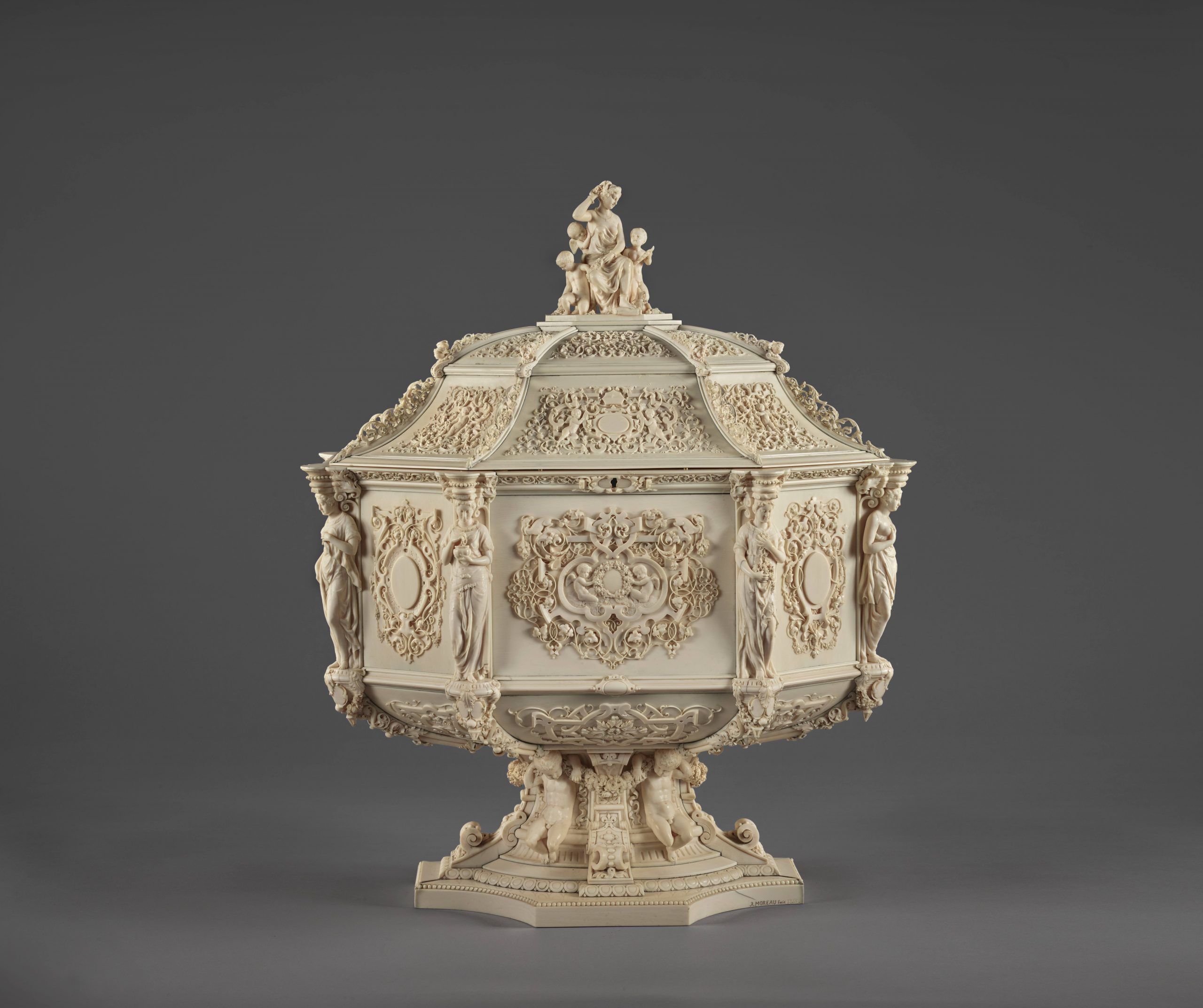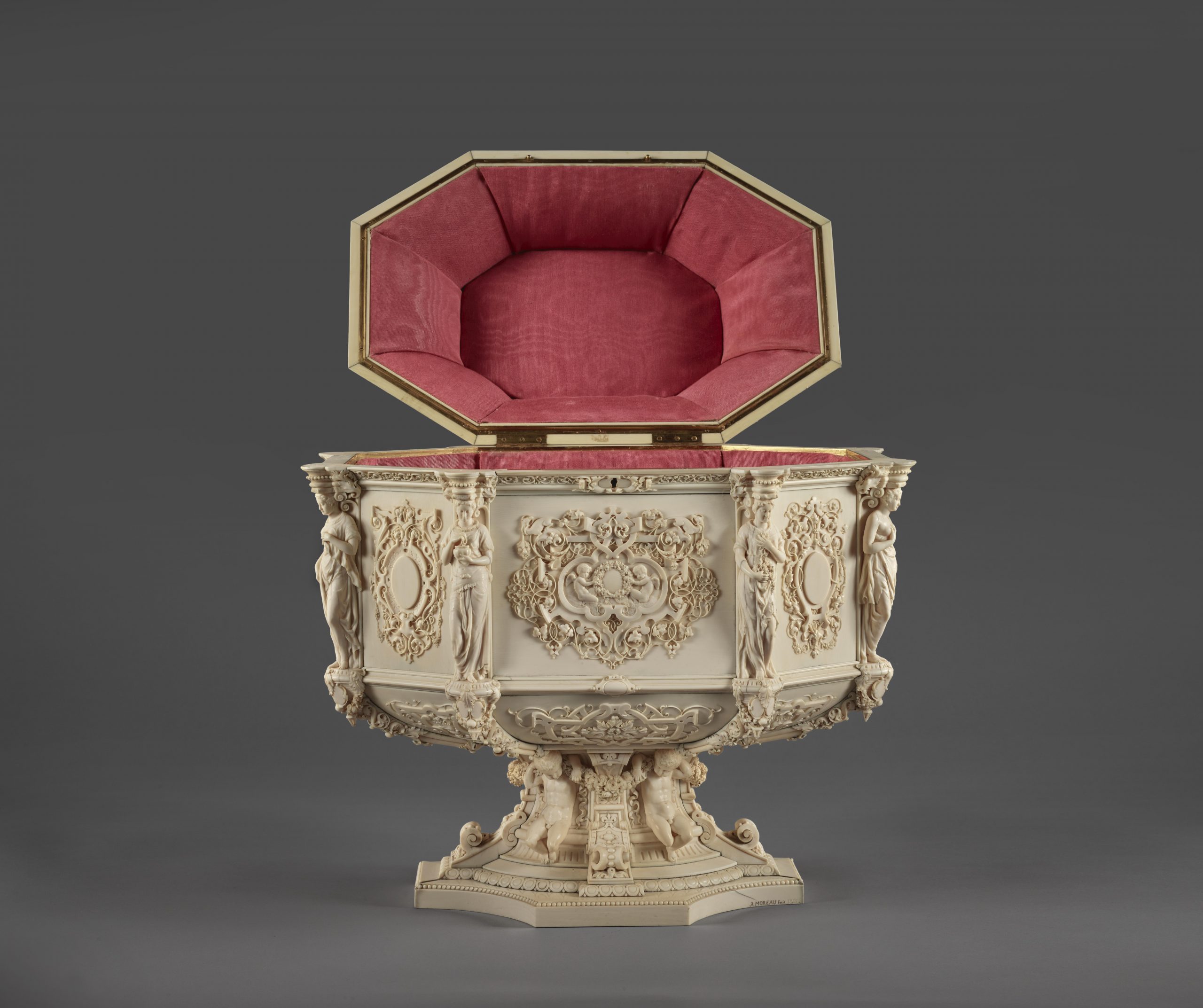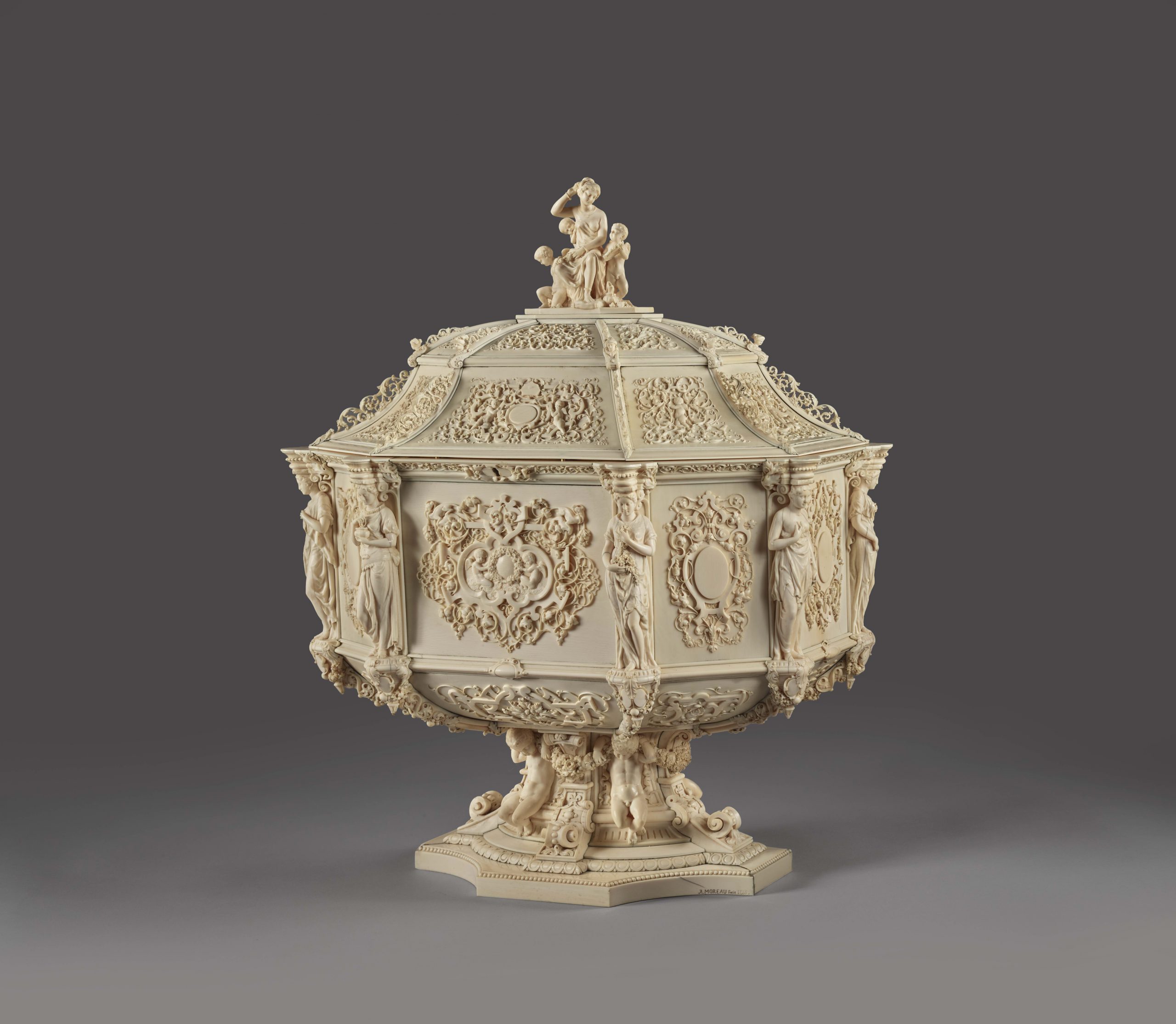Paris, 8 May 1831 – Paris, 16 January 1893
Jewelry Box
Paris, 1855
Elephant ivory, brass, steel, silk velvet (modern inner lining)
MARKS: A. Moreau Fecit 1855 (on the plinth, at the base base)
A. Moreau 1855 (inside, at the bottom of the box)
total height: 60 cm; base: 32 x 19.5; box: 45 x 30 cm
EXHIBITIONS: Presented by “Moreau Père et Fils” at the Exposition Universelle de Paris in 1855 and awarded a First-class medal then at the Exposition Universelle of 1867 (non-competing)
PROVENANCE:
Remained in the possession of the parents of the artist – M. Jean Louis Moreau (1804-1868), and then, Mme Victoire Alexandrine Moreau (née Pérot), probably until 1872, at which date the box was sold at public auction (sold for 2,850 francs) to M. Beugnot (Hôtel Drouot, Paris, Salle 2, 28 December 1872, Me Charles Pillet (cf. Catalogue d’une jolie réunion de bijoux anciens, no. 32 bis); Jean François Beugnot (Avallon, 1805 – New Orleans, 1886), doctor specializing in Infectious Disease and graduate of the Faculté de Paris, in post in New Orleans, Chevalier de la Légion d’Honneur (1854), collector of ivory, private collection, France.
By its compact and resistant nature, ivory lends itself admirably to being shaped into the most varied of forms, and is able to take a high polish. In addition, as a medium, it has been favored by mankind from the very beginning of time. Across the ages and in all cultures, ivories are as much an expression of the sacred as they are of princely rank, as attested to by the large number of pieces featuring in large private collections and museums. In these collections, it is traditional to distinguish two main areas: Medieval ivories (including late Classical ivories) and Modern ivories. It is on these two divisions that writers of history have concentrated, singling out moments through the ages when they were in great demand, alternating with periods of decline.
During the Middle Ages, French ivory-carving was exceptionally renowned, particularly that of Paris which, from the mid-13th to the early 14th century ranked the highest for its production of small religious subjects. Beginning with the Renaissance, on the other hand, and for the entire modern period, it was supplanted by the capitals of the large feudal States of Northern Europe (Flanders, Southern Germany and Austria). It was in Augsburg, Nuremberg and Dresden that the work of ivory-carvers reached its most spectacular expression, with their most extraordinary productions ornamenting the curiosity cabinets of all Europe. This was due in particular to the improvements made in lathes (machine-tools pivoting on a horizontal or vertical axis, used to make cylinder-shaped pieces). In France, the path followed by ivory went by way of Dieppe. Made wealthy by overseas trade, for three centuries Dieppe was the principal focal point for the importation and working of ivory in France, an activity reaching its apogee in the 17th century. In the 18th century, French ivory work as a whole was traditionally seen as a secondary sphere of activity, since its production lacked artistic interest, especially compared to the overpowering competition from porcelain. This proposal however needs to be nuanced, since a great deal of research remains to be done on the late 18th century and the first half of the 19th century, the most neglected period of modern ivory carving.
From the end of the Empire, a cluster of favorable economic and conjunctural circumstances–associated with a profound change in fashion based on archeological discoveries and intense theoretical debate–-progressively favored a renewal of the sculpting of ivory in France. Under the Restauration, ivory working remained a local phenomenon, practiced by a few great dynasties of Dieppe ivory sculptors (among them, the Bellteste, Blard, and Norest families), who—aside from a few pieces commissioned by a clientele of aristocrats visiting the city – most often devoted themselves to the production of devotional objects or steeped in the very picturesque. From 1830, a new generation, including the decorator-sculptors Claude-Aimé Chenavard, Michel Liénard, Jean-Jacques Feuchère, Étienne-Jules Klagmann, and precious metal sculptors Charles Wagner and Froment-Meurice, among others, looked to the Middle Ages and, above all, the Renaissance, for new sources of inspiration to emancipate themselves from the neo-Classical themes that had been exploited for far too long. This taste for the Romantic, lasting until the beginning of the Second Empire, proceeded hand-in-hand with a fascination for the technical aspects of work done in past-times. Like bronze (rediscovered at the same time), ivory came with all the virtues of the modernity which had given rise to a series of technical innovations making it easier to work with or to imitate.Seeing in ivory an excellent material to make delicate replications of their larger sculptures or other, smaller, objects, the great Romantic sculptors Jean-Jacques Pradier, François-Henri de Triqueti and even David d’Angers, who generally worked on a more colossal scale, began to work in ivory around 1845. They were followed by their fellow-sculptors, and, in turn, metal craftsmen began to integrate ivory into their creations, proposing new pieces bringing together ivory and other precious materials. These include the Leda which was referred to as “by the artists”: in gold, silver and precious stones, it was made in collaboration with Pradier and presented at the first Exposition Universelle in 1851.
Comparable in many regards to what happened to enameling at the same period, the renaissance of ivory sculpting was a major occurrence in the history of the arts in 19th century France, a phenomenon whose evolution can be followed thanks to the pieces exhibited during the fairs devoted to Industrial Products, both national and international, the first organized in London in 1851, but also via what was shown at various Salons dedicated to Fine Arts and early publications focusing on the history of ivory
It is thanks to the first treatise written by Louis Nicolas Barbier, “tourneur professeur” (professor of lathe carving) on the occasion of the Exposition of 1855, that we possess most of the information we have on the present object and its creator, Augustin Edme Jean Moreau (1831-1893), known as Moreau-Vauthier. Awarded a First-class medal in 1855 (Fig.1), then exhibited again in 1867 this large neo-Renaissance casket is stylistically wholly within the tradition of the Romantic style that developed with the important commissions from the Duc d’Orléans, and unanimously seen as a masterpiece of virtuosity and artistic feeling.
Associating all of the techniques of modern ivory sculpting (bas-relief, sculpture in the round, tabletterie (precision design and assembling)), in a single object constitutes an important landmark in the history of 19th century French ivory sculpting. Presented along with a large vase and a triptych representing the three theological Virtues, it would seem that the only other box by Moreau comparable to this was the one that he executed for the marriage of Baronne Alphonse de Rothschild, Léonora, called Laure de Rothschild (1837-1911), in 1847 which bears her family coat of arms, sculpted in relief.
He was born in Paris on 8 May 1831, to an ivory-sculptor father.This latter was the first in Paris, it is said, to have expanded the business of ivory sculpting, and was also celebrated for his mastery of the art of guillochage (a decorative technique derived from metal working, done on a lathe, for which he obtained a patent of improvement in 1844). Augustin Moreau spent his childhood in the family workshop on the Rue du Petit Lion Saint Sauveur, in the Montorgueil neighborhood. This is where he apprenticed, following in the footsteps of his father, who distinguished himself at the Expositions des Produits de l’Industrie in 1839 (honorable mention), 1844 (bronze medal) and 1849 (silver medal). Together they would continue this illustrious path at the Exposition Universelle de Paris, first in 1855 and then in 1867. Anxious to progress in his art, he studied at the Beaux-Arts beginning in 1850 under the direction of the sculptor Armand Toussaint (1806-1862), a student of Pradier, who worked with Simart to fashion the famous eburnean Minerva statue at the Château de Dampierre, commissioned by the Duc de Luynes in 1849 and displayed in Paris in 1855. From this moment on, his quest was no less than the grandiose project of bringing back chryselephantine statuary, reviving the techniques used by Phidias for the Athena Parthenos and the Zeus in Olympia. For the young artist, the recognition he obtained at the Exposition Universelle of 1855 was the point of departure of a brilliant life as a sculptor, with public commissions—for the Tuileries and the Hôtel de Ville in particular—regularly marking his career.
Working in marble as well as ivory, it was naturally in ivory that he best expressed his talent in works that form a very characteristic ensemble presented at Salons over thirty-six years, starting in 1857. Among his most important works in ivory, presented during the Exposition Universelle of 1889, a few years before his death, was the famous bust of Gallia ; Fortune, commissioned by William K. Vanderbilt (1849-1920); Andromeda, belonging to a Mrs. Morgan of New York and the Florentine bust, acquired by Henry Walters. He was awarded the title Chevalier de la Légion d’Honneur in 1877, and in 1885 was given the position of professor at the Ecole des Arts Décoratifs.



